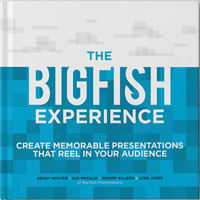How to Mind Map Your Presentation

People frequently email us to ask, “Hey Big Fish, how exactly do you brainstorm your content for your presentations?” After receiving multiple email requests in the last couple of months, we decided to share our self-developed mind mapping technique with the world.
When you are brainstorming the presentation you want to create, follow the below process to mind map out your points. It’s important to remember though, that these steps come before actually outlining and designing your presentation. We recommend creating your big idea first, developing the call to action second, writing three, simple main points that support the call to action, complete the big idea third (look in the structure section), then finally writing your opener last. By following the process this way, you will have the basis to create supporting content in your outline on top of your foundational big idea.
 Figure 1: Follow the steps based on the directions of the arrows.
Figure 1: Follow the steps based on the directions of the arrows.
Step 1 – Develop Your Big Idea: This is your central argument and the main reason you are presenting. Every presentation should have only one main idea to keep focused. A great big idea is one that can be stated in simple terms as the purpose of your presentation. Do not create any presentation without a singular big idea as you can risk overloading your audience with information.
For more info on how to create Big Ideas, see here for a sample chapter in our book The Big Fish Experience.
Step 2: Develop Your Call to Action: Every presentation should have a call to action to influence the audience even after the presentation is over. Without a call to action, you risk the purpose of your big idea being lost to your audience and they will not know what you would like them to do next. There are three different types of calls to action: a question (ex. why should we wait to save money?), a demand (ex. you need to do this now to help save the company money), or offer (ex. if you choose to do X, you will save X in return).
For tips on developing your call to action, see our Slideshare here on tips.
Step 3 – Develop Your Main Points: As people tend to have short attention spans, breaking up your key points into three main points is the best way to support your call to action and big idea. These main points should be memorable and delivered in a twitter-like format (think 140 characters or less). By simplifying main points, it is easier to 1) recap your presentation on what key takeaways your audience should remember and 2) help create supporting content around each main point.
For more on creating a structure/flow for your presentation to support your presentation’s call to action and main idea, see here for tips on structure.
Step 4 – Develop Your Opener: We recommend developing your opener last, as you need the context of the presentation first before you can know how to begin. The opener of a presentation should intrigue the audience members to listen. There are many different ways to open your presentation such as through a story, joke, quote, video, or statistic. We recommend starting off with a small pause then telling either a story or shocking statistic (make sure to compare your statistic to a relatable digestible stat for dramatic effect) based on audience member and context of meeting.
For tips on how to open your presentation, please see here for a blog post that can help you choose the most effective opener.
While this process grew out of necessity in simplifying the presentation process for our clients, the format above is now the presentation format that we use for all our presentations. From the simple internal team project pitch, to the sales deck, to the TED-style keynote, we use this format to make sure all the ideas synergize with one another. Utilize this method on your next presentation to help you speed your creative process up and make your presentation one to remember.
Have any questions, comments, or suggestions on what you believe are the perfect ways to mind map your presentation? Let us know at hq@localhost. And don’t forget to check out our book The Big Fish Experience for more presentation tips – or subscribe to our blog to stay updated on the latest presentation, design, video, and creative trends.
PSST! For tips on web, video, digital strategy, and company culture, check out the newly launched blog of our parent company ThreeSixtyEight here.




Share your opinion.